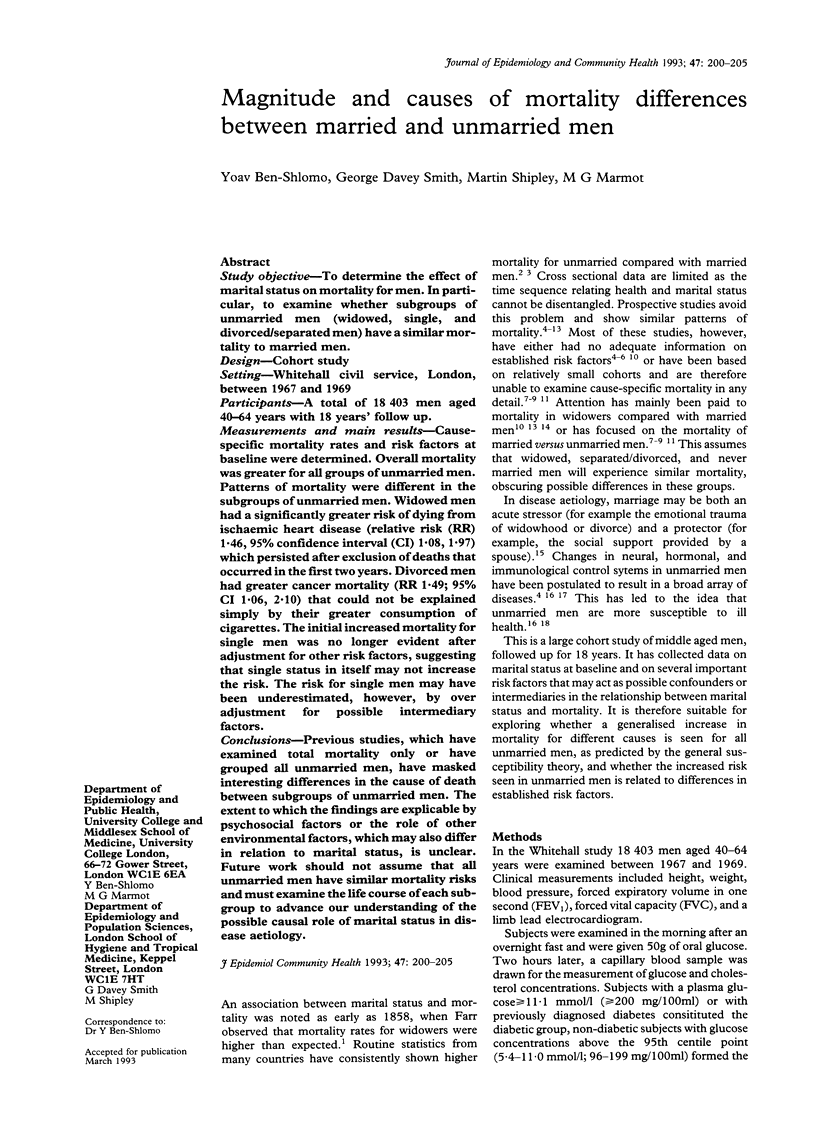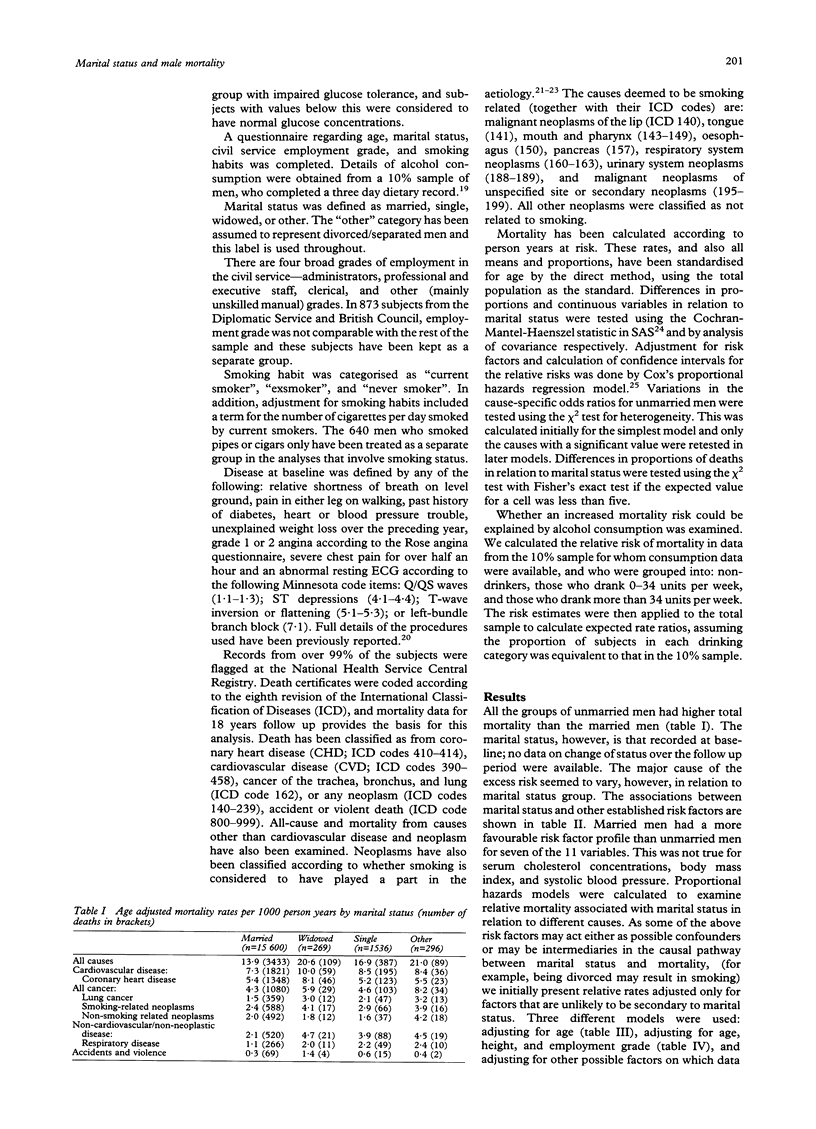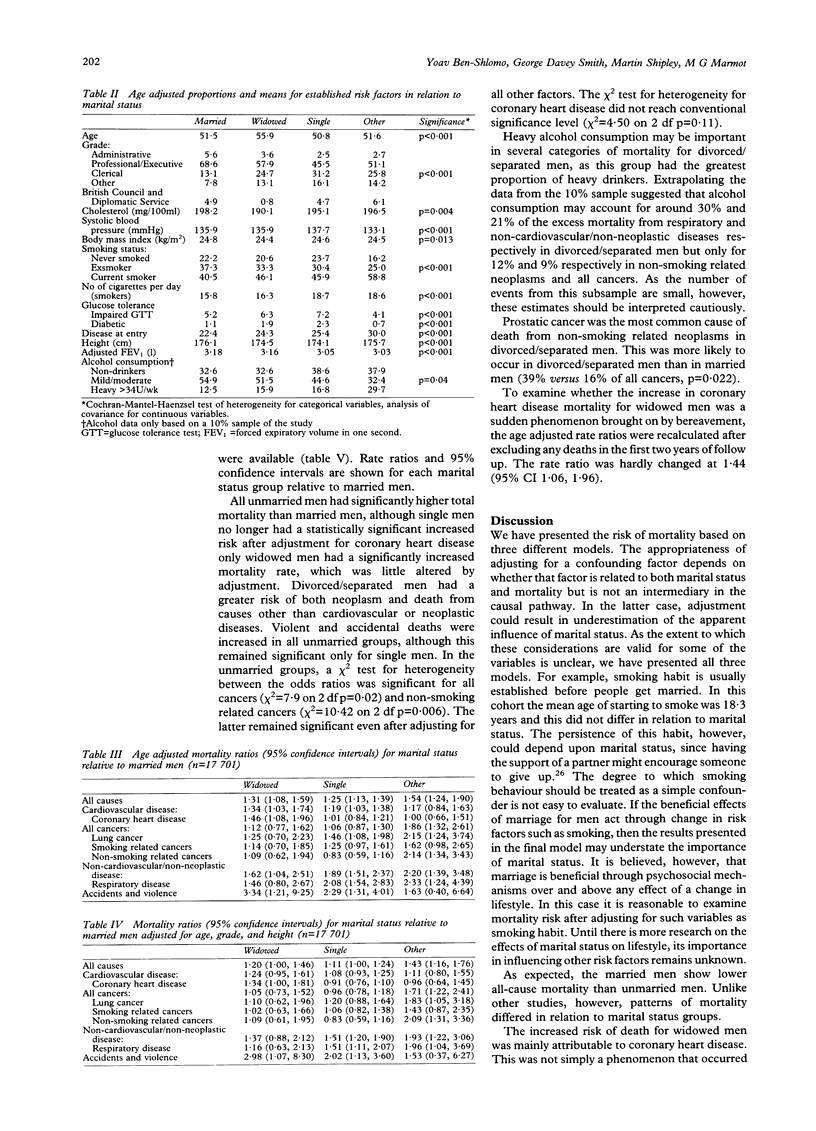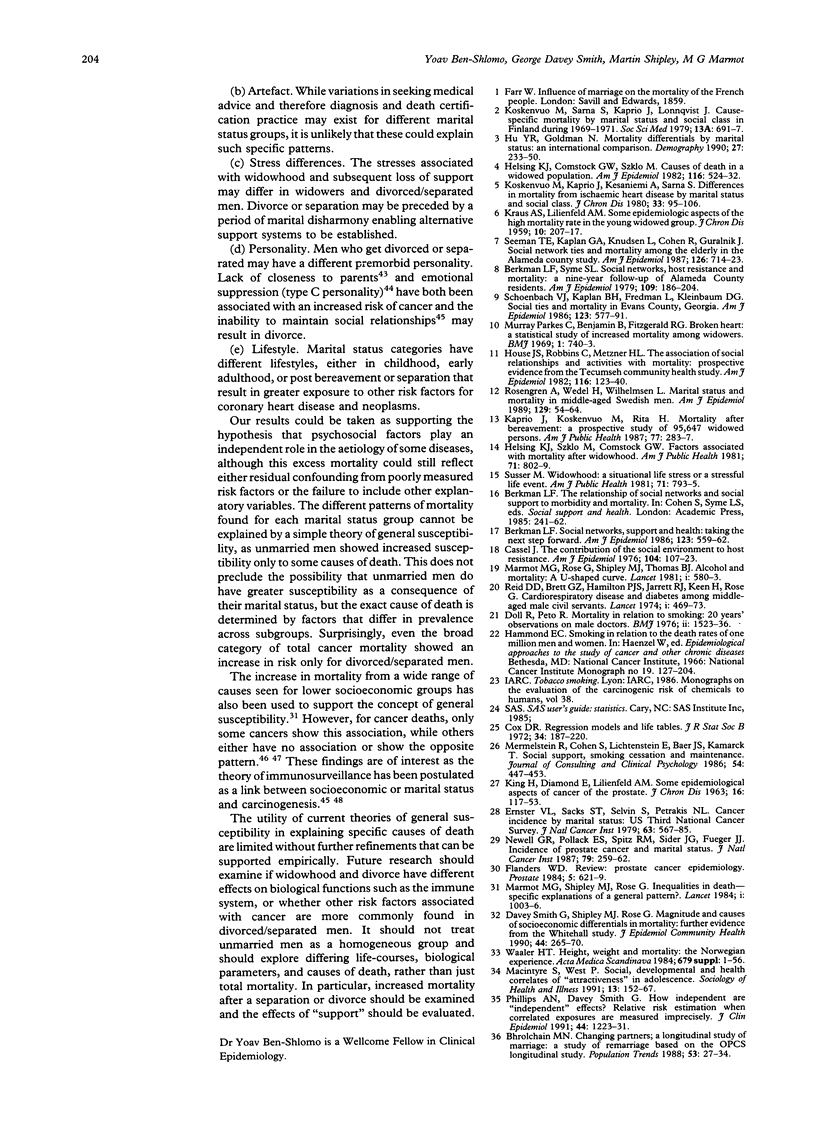Abstract
STUDY OBJECTIVE--To determine the effect of marital status on mortality for men. In particular, to examine whether subgroups of unmarried men (widowed, single, and divorced/separated men) have a similar mortality to married men. DESIGN--Cohort study. SETTING--Whitehall civil service, London, between 1967 and 1969. PARTICIPANTS--A total of 18,403 men aged 40-64 years with 18 years' follow up. MEASUREMENTS AND MAIN RESULTS--Cause-specific mortality rates and risk factors at baseline were determined. Overall mortality was greater for all groups of unmarried men. Patterns of mortality were different in the subgroups of unmarried men. Widowed men had a significantly greater risk of dying from ischaemic heart disease (relative risk (RR) 1.46, 95% confidence interval (CI) 1.08, 1.97) which persisted after exclusion of deaths that occurred in the first two years. Divorced men had greater cancer mortality (RR 1.49; 95% CI 1.06, 2.10) that could not be explained simply by their greater consumption of cigarettes. The initial increased mortality for single men was no longer evident after adjustment for other risk factors, suggesting that single status in itself may not increase the risk. The risk for single men may have been underestimated, however, by over adjustment for possible intermediary factors. CONCLUSIONS--Previous studies, which have examined total mortality only or have grouped all unmarried men, have masked interesting differences in the cause of death between subgroups of unmarried men. The extent to which the findings are explicable by psychosocial factors or the role of other environmental factors, which may also differ in relation to marital status, is unclear. Future work should not assume that all unmarried men have similar mortality risks and must examine the life course of each subgroup to advance our understanding of the possible causal role of marital status in disease aetiology.
Full text
PDF





Selected References
These references are in PubMed. This may not be the complete list of references from this article.
- Baltrusch H. J., Waltz M. Cancer from a biobehavioural and social epidemiological perspective. Soc Sci Med. 1985;20(8):789–794. doi: 10.1016/0277-9536(85)90332-6. [DOI] [PubMed] [Google Scholar]
- Berkman L. F. Social networks, support, and health: taking the next step forward. Am J Epidemiol. 1986 Apr;123(4):559–562. doi: 10.1093/oxfordjournals.aje.a114276. [DOI] [PubMed] [Google Scholar]
- Berkman L. F., Syme S. L. Social networks, host resistance, and mortality: a nine-year follow-up study of Alameda County residents. Am J Epidemiol. 1979 Feb;109(2):186–204. doi: 10.1093/oxfordjournals.aje.a112674. [DOI] [PubMed] [Google Scholar]
- Cassel J. The contribution of the social environment to host resistance: the Fourth Wade Hampton Frost Lecture. Am J Epidemiol. 1976 Aug;104(2):107–123. doi: 10.1093/oxfordjournals.aje.a112281. [DOI] [PubMed] [Google Scholar]
- Cox T., Mackay C. Psychosocial factors and psychophysiological mechanisms in the aetiology and development of cancers. Soc Sci Med. 1982;16(4):381–396. doi: 10.1016/0277-9536(82)90048-x. [DOI] [PubMed] [Google Scholar]
- Ernster V. L., Sacks S. T., Selvin S., Petrakis N. L. Cancer incidence by marital status: U.S. Third National Cancer Survey. J Natl Cancer Inst. 1979 Sep;63(3):567–585. doi: 10.1093/jnci/63.3.567. [DOI] [PubMed] [Google Scholar]
- Flanders W. D. Review: prostate cancer epidemiology. Prostate. 1984;5(6):621–629. doi: 10.1002/pros.2990050608. [DOI] [PubMed] [Google Scholar]
- Greer S., Watson M. Towards a psychobiological model of cancer: psychological considerations. Soc Sci Med. 1985;20(8):773–777. doi: 10.1016/0277-9536(85)90330-2. [DOI] [PubMed] [Google Scholar]
- Hammond E. C. Smoking in relation to the death rates of one million men and women. Natl Cancer Inst Monogr. 1966 Jan;19:127–204. [PubMed] [Google Scholar]
- Helsing K. J., Comstock G. W., Szklo M. Causes of death in a widowed population. Am J Epidemiol. 1982 Sep;116(3):524–532. doi: 10.1093/oxfordjournals.aje.a113436. [DOI] [PubMed] [Google Scholar]
- Helsing K. J., Szklo M., Comstock G. W. Factors associated with mortality after widowhood. Am J Public Health. 1981 Aug;71(8):802–809. doi: 10.2105/ajph.71.8.802. [DOI] [PMC free article] [PubMed] [Google Scholar]
- House J. S., Robbins C., Metzner H. L. The association of social relationships and activities with mortality: prospective evidence from the Tecumseh Community Health Study. Am J Epidemiol. 1982 Jul;116(1):123–140. doi: 10.1093/oxfordjournals.aje.a113387. [DOI] [PubMed] [Google Scholar]
- Hu Y. R., Goldman N. Mortality differentials by marital status: an international comparison. Demography. 1990 May;27(2):233–250. [PubMed] [Google Scholar]
- Jones D. R., Goldblatt P. O., Leon D. A. Bereavement and cancer: some data on deaths of spouses from the longitudinal study of Office of Population Censuses and Surveys. Br Med J (Clin Res Ed) 1984 Aug 25;289(6443):461–464. doi: 10.1136/bmj.289.6443.461. [DOI] [PMC free article] [PubMed] [Google Scholar]
- Jones D. R. Heart disease mortality following widowhood: some results from the OPCS Longitudinal Study. Office of Population Censuses and Surveys. J Psychosom Res. 1987;31(3):325–333. doi: 10.1016/0022-3999(87)90052-3. [DOI] [PubMed] [Google Scholar]
- KING H., DIAMOND E., LILIENELD A. M. Some epidemiological aspects of cancer of the prostate. J Chronic Dis. 1963 Feb;16:117–153. doi: 10.1016/0021-9681(63)90091-2. [DOI] [PubMed] [Google Scholar]
- KRAUS A. S., LILIENFELD A. M. Some epidemiologic aspects of the high mortality rate in the young widowed group. J Chronic Dis. 1959 Sep;10:207–217. doi: 10.1016/0021-9681(59)90003-7. [DOI] [PubMed] [Google Scholar]
- Kaprio J., Koskenvuo M., Rita H. Mortality after bereavement: a prospective study of 95,647 widowed persons. Am J Public Health. 1987 Mar;77(3):283–287. doi: 10.2105/ajph.77.3.283. [DOI] [PMC free article] [PubMed] [Google Scholar]
- Koskenvuo M., Kaprio J., Kesäniemi A., Sarna S. Differences in mortality from ischemic heart disease by marital status and social class. J Chronic Dis. 1980;33(2):95–106. doi: 10.1016/0021-9681(80)90033-8. [DOI] [PubMed] [Google Scholar]
- Koskenvuo M., Sarna S., Kaprio J., Lönnqvist J. Cause-specific mortality by marital status and social class in Finland during 1969--1971. Soc Sci Med Med Psychol Med Sociol. 1979 Nov;13A(6):691–697. doi: 10.1016/0271-7123(79)90114-7. [DOI] [PubMed] [Google Scholar]
- Kotler P., Wingard D. L. The effect of occupational, marital and parental roles on mortality: the Alameda County Study. Am J Public Health. 1989 May;79(5):607–612. doi: 10.2105/ajph.79.5.607. [DOI] [PMC free article] [PubMed] [Google Scholar]
- Marmot M. G., Rose G., Shipley M. J., Thomas B. J. Alcohol and mortality: a U-shaped curve. Lancet. 1981 Mar 14;1(8220 Pt 1):580–583. doi: 10.1016/s0140-6736(81)92032-8. [DOI] [PubMed] [Google Scholar]
- Marmot M. G., Shipley M. J., Rose G. Inequalities in death--specific explanations of a general pattern? Lancet. 1984 May 5;1(8384):1003–1006. doi: 10.1016/s0140-6736(84)92337-7. [DOI] [PubMed] [Google Scholar]
- Mermelstein R., Cohen S., Lichtenstein E., Baer J. S., Kamarck T. Social support and smoking cessation and maintenance. J Consult Clin Psychol. 1986 Aug;54(4):447–453. doi: 10.1037//0022-006x.54.4.447. [DOI] [PubMed] [Google Scholar]
- Newell G. R., Pollack E. S., Spitz M. R., Sider J. G., Fueger J. J. Incidence of prostate cancer and marital status. J Natl Cancer Inst. 1987 Aug;79(2):259–262. [PubMed] [Google Scholar]
- Parkes C. M., Benjamin B., Fitzgerald R. G. Broken heart: a statistical study of increased mortality among widowers. Br Med J. 1969 Mar 22;1(5646):740–743. doi: 10.1136/bmj.1.5646.740. [DOI] [PMC free article] [PubMed] [Google Scholar]
- Phillips A. N., Smith G. D. How independent are "independent" effects? Relative risk estimation when correlated exposures are measured imprecisely. J Clin Epidemiol. 1991;44(11):1223–1231. doi: 10.1016/0895-4356(91)90155-3. [DOI] [PubMed] [Google Scholar]
- Reed D., McGee D., Yano K. Psychosocial processes and general susceptibility to chronic disease. Am J Epidemiol. 1984 Mar;119(3):356–370. doi: 10.1093/oxfordjournals.aje.a113754. [DOI] [PubMed] [Google Scholar]
- Reid D. D., Brett G. Z., Hamilton P. J., Jarrett R. J., Keen H., Rose G. Cardiorespiratory disease and diabetes among middle-aged male Civil Servants. A study of screening and intervention. Lancet. 1974 Mar 23;1(7856):469–473. doi: 10.1016/s0140-6736(74)92783-4. [DOI] [PubMed] [Google Scholar]
- Rimpelä A. H., Pukkala E. I. Cancers of affluence: positive social class gradient and rising incidence trend in some cancer forms. Soc Sci Med. 1987;24(7):601–606. doi: 10.1016/0277-9536(87)90064-5. [DOI] [PubMed] [Google Scholar]
- Rosengren A., Wedel H., Wilhelmsen L. Marital status and mortality in middle-aged Swedish men. Am J Epidemiol. 1989 Jan;129(1):54–64. doi: 10.1093/oxfordjournals.aje.a115124. [DOI] [PubMed] [Google Scholar]
- Schoenbach V. J., Kaplan B. H., Fredman L., Kleinbaum D. G. Social ties and mortality in Evans County, Georgia. Am J Epidemiol. 1986 Apr;123(4):577–591. doi: 10.1093/oxfordjournals.aje.a114278. [DOI] [PubMed] [Google Scholar]
- Seeman T. E., Kaplan G. A., Knudsen L., Cohen R., Guralnik J. Social network ties and mortality among the elderly in the Alameda County Study. Am J Epidemiol. 1987 Oct;126(4):714–723. doi: 10.1093/oxfordjournals.aje.a114711. [DOI] [PubMed] [Google Scholar]
- Smith G. D., Leon D., Shipley M. J., Rose G. Socioeconomic differentials in cancer among men. Int J Epidemiol. 1991 Jun;20(2):339–345. doi: 10.1093/ije/20.2.339. [DOI] [PubMed] [Google Scholar]
- Smith G. D., Shipley M. J., Rose G. Magnitude and causes of socioeconomic differentials in mortality: further evidence from the Whitehall Study. J Epidemiol Community Health. 1990 Dec;44(4):265–270. doi: 10.1136/jech.44.4.265. [DOI] [PMC free article] [PubMed] [Google Scholar]
- Susser M. Widowhood: a situational life stress or a stressful life event? Am J Public Health. 1981 Aug;71(8):793–795. doi: 10.2105/ajph.71.8.793. [DOI] [PMC free article] [PubMed] [Google Scholar]
- Thomas C. B. Precursors of premature disease and death. The predictive potential of habits and family attitudes. Ann Intern Med. 1976 Nov;85(5):653–658. doi: 10.7326/0003-4819-85-5-653. [DOI] [PubMed] [Google Scholar]
- Venters M., Jacobs D. R., Jr, Pirie P., Luepker R. V., Folsom A. R., Gillum R. F. Marital status and cardiovascular risk: the Minnesota Heart Survey and the Minnesota Heart Health Program. Prev Med. 1986 Nov;15(6):591–605. doi: 10.1016/0091-7435(86)90064-2. [DOI] [PubMed] [Google Scholar]
- Waaler H. T. Height, weight and mortality. The Norwegian experience. Acta Med Scand Suppl. 1984;679:1–56. doi: 10.1111/j.0954-6820.1984.tb12901.x. [DOI] [PubMed] [Google Scholar]


